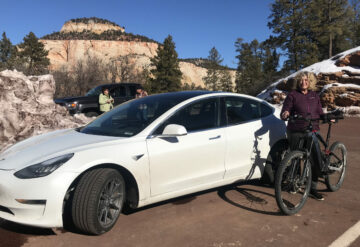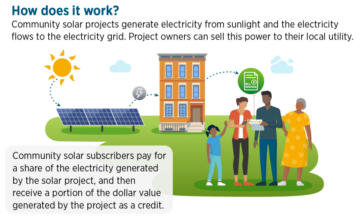Sign up for daily news updates from CleanTechnica on email. Or follow us on Google News!
Recently, U.S. Senator Marco Rubio started pushing for more tariffs. Why? Because cheaper Chinese electric cars have a pretty good chance of destroying vehicle manufacturing in the United States. While this is a reasonable argument to make, tariffs alone would only delay the inevitable, so more must be done if the goal is to protect the U.S. automotive industry.
First, let’s look at Rubio’s proposal:
Placing tariffs on Chinese imports and closing loopholes is key to preventing China from infiltrating our markets and stealing American jobs.https://t.co/ZtyThlmsGC
— Senator Marco Rubio (@SenMarcoRubio) March 10, 2024
An article at The Center Square goes into more detail on Rubio’s proposal.
For some background, we need to consider that there are already tariffs on EVs made in China and they’re also not eligible for consumer tax credits, putting them at a double disadvantage. But, BYD is considering opening a factory in Mexico, which would put them into the jurisdiction of the USMCA, the agreement that replaced NAFTA. This means tariffs go from 27.5% down to only 2.5%. When we consider that BYD is offering EVs at prices that would seriously undercut expensive U.S.-made EVs, even after tax credits, this presents a serious problem.
To combat this, Rubio wants to both subject existing tariffs on all Chinese companies, regardless of whether they build the vehicles elsewhere (the Closing Auto Tariffs Loopholes Act) and add a new flat $20,000 tariff on all Chinese vehicles (Strengthening Tariffs on Chinese Autos Act). Finally, the American Subsidies for American Autos Act would require compliance with USMCA for any Mexican-made vehicle to be eligible for tax credits.
I agree with Rubio that these tariffs are necessary, or at least some of them. United States automakers are simply not delivering EVs cheap enough to compete, and geopolitical realities dictate that we don’t let the United States become dependent on China for EVs. It’s also true that without more export markets for their cars, Chinese industry is in trouble, and we’d be better off to let them experience trouble right now, because sending even more U.S. money to China while its government spends money preparing to go to war with us is suicidal.
So, it’s not an exaggeration to say that the future of the free world is at stake here.
Tariffs Aren’t Enough, Though
But, doing tariffs alone would be bad for automakers. Giving them some breathing room while most of them do the wrong thing means we can expect them to double down on bad behavior. The fact is that they’ve spent decades getting to this point, and we simply don’t have decades for them to turn around.
The biggest problem is that almost nobody is offering affordable EVs right now. Nissan has the very-substandard LEAF, and that’s going to be discontinued soon. GM had the Bolt and Bolt EUV, but those went out of production a few months ago. Basically everything else is priced at around $50,000 and up.
In theory, the idea of starting a new technology at the top of the market works. Automakers did this for decades with everything from power windows to dual overhead cams. A new, expensive technology goes to Lincoln and Cadillac first, gets paid for, and then trickles down to Ford and Chevy later as the price drops and mass production becomes possible. So, this strategy of starting out with $100,000 pickup trucks (Silverado EV) and $60,000 luxury EVs does make sense.
In practice, though, automakers missed the boat on that strategy. The right time to be offering expensive EVs with a plan to trickle the technology down into lower markets was a decade ago, when Tesla was doing that. Now, expensive EVs have to compete with the $39,000 Model 3, and that’s before the point-of-sale tax credit that works like a discount now, so the actual price a buyer pays is around $31,500, and it’s cheaper in states with their own state-level rebates.
Fuck Around and Find Out. Full Video. pic.twitter.com/fZb3JDUUW0
— Roger Skaer (@rogerskaer) October 1, 2022
So, because most automakers FA’d for a decade on something very important, they’re now facing a decade’s worth of finding out. It’s basic FAFO math, and while they may want to dispute it, they’ve still gotta live with it.
They’ve managed to live with the FAFO conundrum they created so far because many people don’t want to buy a Tesla. Things like Elon Musk’s antics, the styling, and people’s existing brand preferences all play a role there. But, when BYD comes to town with EVs that undercut even Tesla’s, and by a wide margin, the amount of held-back finding out will start to leak. And, when dams leak, it isn’t long before the whole thing comes down and there’s a major flood.
History proves this out. Japanese automakers got a serious beachhead in the U.S. auto market when domestic automakers were F’ing around in the ’70s and ’80s. Then came a flood of superior and efficient Japanese cars, followed by Korean cars that have vastly improved in quality. Chinese automakers, with a lot of help from the Communist Party, were getting serious about EVs and batteries while the domestic automakers were messing around.
History doesn’t really repeat itself, but it often rhymes.
So, if the U.S. government wants to hold back the tide of cheap Chinese EVs, there’d better be some effort put into getting domestic automakers to stop F’ing around, because holding back the FAFO only means more water behind the dam that will eventually result in a lot of finding out all at once.
So, the government really needs to start holding automakers accountable now.
Possible Ways To Get Non-Tesla Domestic Automakers Back On Track
The price cap for EV tax credits probably needs to be revised to lower over the next ten years to hurry domestic automakers along while the tariff dam temporarily holds Chinese automakers back. Their complacency at the top of the market can’t be rewarded anymore. Other things, like more subsidies for battery production (this is how Chinese EVs got so cheap) need to happen to help automakers get better pricing going.
Manufacturing is another area where the United States could do better than China in the 21st century. While Tesla’s “alien dreadnought” fully-automated factory didn’t work out, that doesn’t mean increased and eventually near-full automation will never happen. More manufacturable designs, like cast frames, are being experimented with and put into production, but with concerns over repairability. Other, more radical things, like Aptera’s use of pressed composite body parts, could be good, but investors are skeptical.
Getting these innovations and others is going to require more investment in research, and that’s something today’s companies don’t do like they used to because they can’t survive without thinking in terms of what works this quarter. There could be some room for government to fund research in manufacturing and manufacturability that won’t be profitable fast enough for investors to be interested in.
Whatever the U.S. chooses to do about this, we can’t just set higher tariffs with fewer exceptions and then hope it works out. That’s just a recipe for delaying failure until later.
Featured image by BYD.
Have a tip for CleanTechnica? Want to advertise? Want to suggest a guest for our CleanTech Talk podcast? Contact us here.
Latest CleanTechnica TV Video
[embedded content]
Advertisement
CleanTechnica uses affiliate links. See our policy here.
- SEO Powered Content & PR Distribution. Get Amplified Today.
- PlatoData.Network Vertical Generative Ai. Empower Yourself. Access Here.
- PlatoAiStream. Web3 Intelligence. Knowledge Amplified. Access Here.
- PlatoESG. Carbon, CleanTech, Energy, Environment, Solar, Waste Management. Access Here.
- PlatoHealth. Biotech and Clinical Trials Intelligence. Access Here.
- Source: https://cleantechnica.com/2024/03/13/tariffs-arent-enough-to-save-u-s-manufacturers-from-chinese-evs/
- :has
- :is
- :not
- :where
- $UP
- 000
- 1
- 10
- 2%
- 21st
- 27
- 4
- 400
- 500
- a
- About
- accountable
- Act
- actual
- add
- Advertise
- Affiliate
- affordable
- After
- ago
- agree
- Agreement
- All
- almost
- alone
- along
- already
- also
- American
- amount
- an
- and
- Another
- any
- anymore
- ARE
- AREA
- argument
- around
- article
- AS
- At
- auto
- automakers
- Automation
- automotive
- automotive industry
- back
- background
- Bad
- basic
- Basically
- batteries
- battery
- battery production
- BE
- because
- become
- becomes
- before
- behavior
- behind
- being
- Better
- Biggest
- boat
- body
- Bolt
- both
- brand
- breathing
- build
- but
- buy
- BUYER..
- by
- byd
- Cadillac
- came
- CAN
- cap
- cars
- Center
- Century
- Chance
- cheap
- cheaper
- China
- chinese
- chooses
- cleantech
- Cleantech Talk
- closing
- combat
- comes
- Companies
- compete
- compliance
- Concerns
- Consider
- considering
- consumer
- content
- conundrum
- could
- created
- credit
- Credits
- decade
- decades
- delay
- delivering
- dependent
- designs
- dictate
- DID
- Disadvantage
- Discount
- Dispute
- do
- does
- Doesn’t
- doing
- Domestic
- done
- Dont
- double
- down
- Drops
- dual
- efficient
- effort
- Electric
- electric cars
- eligible
- Elon
- Elon Musk’s
- else
- elsewhere
- embedded
- enough
- EV
- Even
- eventually
- everything
- evs
- existing
- expect
- expensive
- experience
- export
- facing
- fact
- factory
- Failure
- far
- FAST
- few
- fewer
- Finally
- Find
- finding
- First
- flat
- flood
- followed
- For
- For Investors
- Ford
- Free
- from
- full
- fund
- future
- geopolitical
- get
- gets
- getting
- Giving
- GM
- Go
- goal
- Goes
- going
- good
- got
- Government
- Guest
- had
- happen
- Have
- help
- here
- higher
- hold
- holding
- holds
- hope
- How
- HTML
- HTTPS
- idea
- if
- image
- important
- imports
- improved
- in
- increased
- industry
- inevitable
- innovations
- interested
- into
- investment
- Investors
- IT
- ITS
- itself
- Japanese
- Jobs
- jurisdiction
- just
- Key
- Korean
- later
- leak
- least
- let
- like
- Lincoln
- links
- live
- Long
- Look
- loopholes
- Lot
- lower
- Luxury
- made
- major
- make
- managed
- Manufacturers
- manufacturing
- many
- many people
- Marco
- Margin
- Market
- Markets
- Mass
- math
- max-width
- May..
- mean
- means
- Mexico
- missed
- model
- money
- months
- more
- most
- must
- necessary
- Need
- needs
- never
- New
- news
- next
- Nissan
- nobody
- now
- of
- off
- offering
- often
- on
- once
- only
- opening
- or
- Other
- Others
- our
- out
- over
- overhead
- own
- paid
- parts
- party
- pays
- People
- people’s
- Pickup
- plan
- plato
- Plato Data Intelligence
- PlatoData
- Play
- player
- podcast
- Point
- policy
- possible
- power
- practice
- preferences
- preparing
- presents
- pretty
- preventing
- price
- Prices
- pricing
- probably
- Problem
- Production
- profitable
- proposal
- protect
- proves
- Pushing
- put
- Putting
- quality
- Quarter
- radical
- realities
- really
- reasonable
- rebates
- recipe
- Regardless
- repeat
- replaced
- require
- research
- result
- rewarded
- rhymes
- right
- Role
- Room
- s
- Save
- say
- see
- Senator
- sending
- sense
- serious
- seriously
- set
- simply
- skeptical
- So
- so Far
- some
- something
- Soon
- spends
- spent
- stake
- start
- started
- Starting
- States
- Still
- Stop
- Strategy
- strengthening
- subject
- suggest
- superior
- survive
- T
- Talk
- tariffs
- tax
- tax credit
- Technology
- ten
- terms
- Tesla
- than
- that
- The
- The Future
- their
- Them
- then
- theory
- There.
- These
- they
- thing
- things
- Thinking
- this
- those
- though?
- Tide
- time
- tip
- to
- today’s
- top
- town
- trouble
- Trucks
- true
- TURN
- tv
- u.s.
- U.S. government
- United
- United States
- until
- Updates
- us
- use
- used
- uses
- vehicle
- Vehicles
- very
- Video
- want
- wants
- war
- was
- Water
- ways
- we
- went
- were
- What
- when
- whether
- which
- while
- whole
- why
- wide
- will
- windows
- with
- without
- Work
- work out
- works
- world
- worth
- would
- Wrong
- years
- youtube
- zephyrnet











